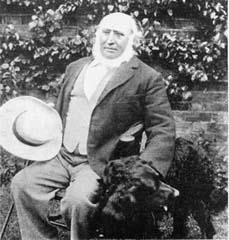Richard Doddridge Blackmore (Richard Doddridge Blackmore)

British Author. He is best remembered for his novel “Lorna Doone” (1869), a recreation of his native Exmoor during the 17th century, which established him in the front rank of British novelists of that time. He was born at Longworth in Berkshire (now Oxfordshire), England where his father was Curate-in-Charge of the local parish. His mother died from typhus a few months after his birth and his father moved several times and he was taken to live with his aunt. In 1831 his father remarried and he returned to live with him. In 1837 he entered Blundell’s School in Tiverton where he excelled in classical studies, and later won a scholarship to Oxford University, graduating in 1847. After leaving Oxford and spending some time as a private tutor, he decided on a career in law and entered law school at Middle Temple, London, England in 1849 and was called to the Bar in 1852. His health prevented him from continuing legal work as a full-time occupation and in 1854, he became the classics master at Wellesley House Grammar School, Hampton Road, Twickenham. Soon after accepting this position, he moved from London to Hampton Wick and remained there until he moved to his new home in Teddington, Middlesex, in the London Borough of Richmond. In September 1857, his uncle died and left his him a sum of money which enabled him to realize a long-held ambition of possessing a house in the country encompassed by a large garden. The land he chose was a 16-acre plot at Teddington, which he had seen and admired for some time. Here he built his new house that was completed in 1860 in which he lived for the rest of his life. He named it “Gomer House” after one of his favorite dogs. In the extensive grounds he created an 11-acre market garden specializing in the cultivation of fruit. While his knowledge of horticulture was extensive, he lacked the necessary business sense and the garden did not become a very lucrative enterprise. He was often referred to as the “Last Victorian,” and acted as a pioneer of the new romantic movement in fiction that continued with Robert Louis Stevenson and others. Though very popular in his time, his work has since been largely ignored. Except for “Lorna Doone,” which has enjoyed considerable ongoing popularity, his entire body of work has gone out of publication. His other literary works include “Poems by Melanter” (1854), “Epullia” (1854), “The Bugle of the Black Sea” (1855), “The Fate of Franklin” (1860), “Farm and Fruit of Old” (1862). “Clara Vaughan” (1864), “Craddock Nowell” (1866), “The Maid of Sker” (1872), “Alice Lorraine” (1875), “Cripps the Carrier” (1876), “Erema” (1877), “Mary Anerley” (1880), “Christowell” (1882), “Sir Thomas Upmore” (1884), “Springhaven” (1887), “Kit and Kitty” (1890), “Perlycross” (1894), “Fringilla” (1895), “Tales from a Telling House” (1896), and “Dariel” (1897). He died at his home in Teddington at the age of 74 after a long and painful illness. (bio by: William Bjornstad)
Born
- June, 07, 1825
- England
Died
- January, 01, 1900
- England
Cemetery
- Exeter Cathedral
- Devon
- England

